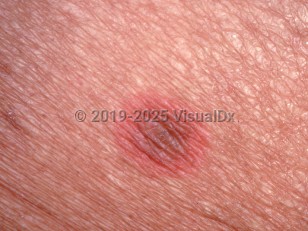Fixed drug eruption - Oral Mucosal Lesion
See also in: Overview,Cellulitis DDx,AnogenitalAlerts and Notices
Important News & Links
Synopsis

Lesions begin as sharply demarcated, red or violaceous patches and are often 0.5 cm to several centimeters in size or larger. Occasionally, these lesions will form vesicles or bullae, and on the mucosal skin, they can present as erosions or appear similar to aphthous ulcers. They are often associated with symptoms of burning, but may also be painful or pruritic. The most common presentation is with a solitary lesion, but some individuals may develop multiple lesions. Healing with postinflammatory hyperpigmentation is less commonly seen after oral mucosal involvement.
Numerous drugs have been implicated in causing FDE. Studies have shown certain drugs appear to have a predilection for causing the eruption to occur in or near the mouth. Commonly associated drug classes for FDE in the oral mucosal region are also the most frequently seen culprit medications for FDE in general. These medication classes include antibiotics, in particular sulfonamides, trimethoprim, and tetracyclines, and NSAIDs, including naproxen, ibuprofen, and celecoxib. Other drugs implicated in FDE include amoxicillin, erythromycin, metronidazole, fluconazole, paracetamol (acetaminophen), cetirizine, hydroxyzine, methylphenidate, oral contraceptives, quinine, and phenolphthalein. A nonpigmenting variant is seen with pseudoephedrine.
Codes
L27.1 – Localized skin eruption due to drugs and medicaments taken internally
SNOMEDCT:
73692007 – Fixed drug eruption
Look For
Subscription Required
Diagnostic Pearls
Subscription Required
Differential Diagnosis & Pitfalls

Subscription Required
Best Tests
Subscription Required
Management Pearls
Subscription Required
Therapy
Subscription Required
Drug Reaction Data
Subscription Required
References
Subscription Required
Last Updated:02/08/2021
 Patient Information for Fixed drug eruption - Oral Mucosal Lesion
Patient Information for Fixed drug eruption - Oral Mucosal Lesion- Improve treatment compliance
- Reduce after-hours questions
- Increase patient engagement and satisfaction
- Written in clear, easy-to-understand language. No confusing jargon.
- Available in English and Spanish
- Print out or email directly to your patient


